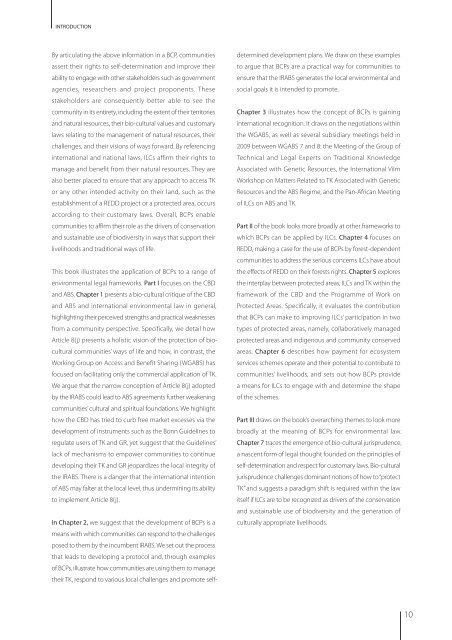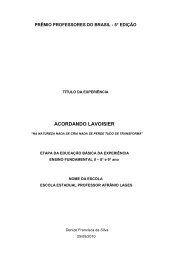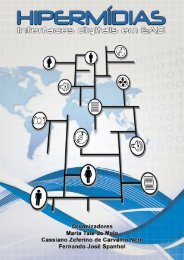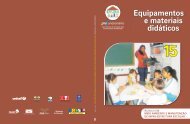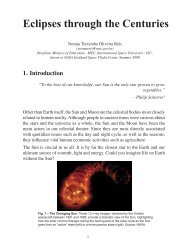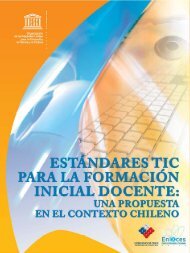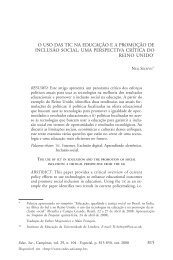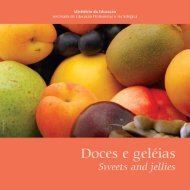BIO-CULTURAL COMMUNITY PROTOCOLS - Portal do Professor
BIO-CULTURAL COMMUNITY PROTOCOLS - Portal do Professor
BIO-CULTURAL COMMUNITY PROTOCOLS - Portal do Professor
Create successful ePaper yourself
Turn your PDF publications into a flip-book with our unique Google optimized e-Paper software.
INTRODUCTION<br />
By articulating the above information in a BCP, communities<br />
assert their rights to self-determination and improve their<br />
ability to engage with other stakeholders such as government<br />
agencies, researchers and project proponents. These<br />
stakeholders are consequently better able to see the<br />
community in its entirety, including the extent of their territories<br />
and natural resources, their bio-cultural values and customary<br />
laws relating to the management of natural resources, their<br />
challenges, and their visions of ways forward. By referencing<br />
international and national laws, ILCs affirm their rights to<br />
manage and benefit from their natural resources. They are<br />
also better placed to ensure that any approach to access TK<br />
or any other intended activity on their land, such as the<br />
establishment of a REDD project or a protected area, occurs<br />
according to their customary laws. Overall, BCPs enable<br />
communities to affirm their role as the drivers of conservation<br />
and sustainable use of biodiversity in ways that support their<br />
livelihoods and traditional ways of life.<br />
This book illustrates the application of BCPs to a range of<br />
environmental legal frameworks. Part I focuses on the CBD<br />
and ABS. Chapter 1 presents a bio-cultural critique of the CBD<br />
and ABS and international environmental law in general,<br />
highlighting their perceived strengths and practical weaknesses<br />
from a community perspective. Specifically, we detail how<br />
Article 8(j) presents a holistic vision of the protection of biocultural<br />
communities’ ways of life and how, in contrast, the<br />
Working Group on Access and Benefit Sharing (WGABS) has<br />
focused on facilitating only the commercial application of TK.<br />
We argue that the narrow conception of Article 8(j) a<strong>do</strong>pted<br />
by the IRABS could lead to ABS agreements further weakening<br />
communities’ cultural and spiritual foundations. We highlight<br />
how the CBD has tried to curb free market excesses via the<br />
development of instruments such as the Bonn Guidelines to<br />
regulate users of TK and GR, yet suggest that the Guidelines’<br />
lack of mechanisms to empower communities to continue<br />
developing their TK and GR jeopardizes the local integrity of<br />
the IRABS. There is a danger that the international intention<br />
of ABS may falter at the local level, thus undermining its ability<br />
to implement Article 8(j).<br />
In Chapter 2, we suggest that the development of BCPs is a<br />
means with which communities can respond to the challenges<br />
posed to them by the incumbent IRABS. We set out the process<br />
that leads to developing a protocol and, through examples<br />
of BCPs, illustrate how communities are using them to manage<br />
their TK, respond to various local challenges and promote self-<br />
determined development plans. We draw on these examples<br />
to argue that BCPs are a practical way for communities to<br />
ensure that the IRABS generates the local environmental and<br />
social goals it is intended to promote.<br />
Chapter 3 illustrates how the concept of BCPs is gaining<br />
international recognition. It draws on the negotiations within<br />
the WGABS, as well as several subsidiary meetings held in<br />
2009 between WGABS 7 and 8: the Meeting of the Group of<br />
Technical and Legal Experts on Traditional Knowledge<br />
Associated with Genetic Resources, the International Vilm<br />
Workshop on Matters Related to TK Associated with Genetic<br />
Resources and the ABS Regime, and the Pan-African Meeting<br />
of ILCs on ABS and TK.<br />
Part II of the book looks more broadly at other frameworks to<br />
which BCPs can be applied by ILCs. Chapter 4 focuses on<br />
REDD, making a case for the use of BCPs by forest-dependent<br />
communities to address the serious concerns ILCs have about<br />
the effects of REDD on their forests rights. Chapter 5 explores<br />
the interplay between protected areas, ILCs and TK within the<br />
framework of the CBD and the Programme of Work on<br />
Protected Areas. Specifically, it evaluates the contribution<br />
that BCPs can make to improving ILCs’ participation in two<br />
types of protected areas, namely, collaboratively managed<br />
protected areas and indigenous and community conserved<br />
areas. Chapter 6 describes how payment for ecosystem<br />
services schemes operate and their potential to contribute to<br />
communities’ livelihoods, and sets out how BCPs provide<br />
a means for ILCs to engage with and determine the shape<br />
of the schemes.<br />
Part III draws on the book’s overarching themes to look more<br />
broadly at the meaning of BCPs for environmental law.<br />
Chapter 7 traces the emergence of bio-cultural jurisprudence,<br />
a nascent form of legal thought founded on the principles of<br />
self-determination and respect for customary laws. Bio-cultural<br />
jurisprudence challenges <strong>do</strong>minant notions of how to “protect<br />
TK” and suggests a paradigm shift is required within the law<br />
itself if ILCs are to be recognized as drivers of the conservation<br />
and sustainable use of biodiversity and the generation of<br />
culturally appropriate livelihoods.<br />
10


